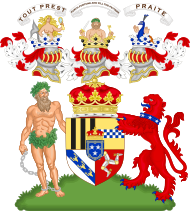
Back Clan Murray German Clan Murray French שבט מארי HE Klan Murray Polish Клан Мюррей Russian Клан Мюррей Ukrainian Thị tộc Murray Vietnamese
| Clan Murray | |||
|---|---|---|---|
| Moireach | |||
 Crest: On a Wreath Or and Sable a demi-savage Proper wreathed about the temples and waist with laurel, his arms extended and holding in the right hand a dagger, in the left a key all Proper. | |||
| Motto | Furth fortune and fill the fetters[1] | ||
| Profile | |||
| Region | Highlands and Lowlands | ||
| Plant badge | Butcher's Broom,[1] or Juniper | ||
| Pipe music | The Atholl Highlanders | ||
| Chief | |||
 | |||
| Bruce Murray | |||
| 12th Duke of Atholl | |||
| Seat | Blair Castle[2] | ||
| Historic seat | Bothwell Castle[2] | ||
| |||
| |||
| |||
| |||
Clan Murray () is a Highland Scottish clan.[3] The chief of the Clan Murray holds the title of Duke of Atholl. Their ancestors were the Morays of Bothwell who established the family in Scotland in the 12th century. In the 16th century, descendants of the Morays of Bothwell, the Murrays of Tullibardine, secured the chiefship of the clan and were created Earls of Tullibardine in 1606. The first Earl of Tullibardine married the heiress to the Stewart earldom of Atholl and Atholl therefore became a Murray earldom in 1626. The Murray Earl of Atholl was created Marquess of Atholl in 1676 and in 1703 it became a dukedom. The marquess of Tullibardine title has continued as a subsidiary title, being bestowed on elder sons of the chief until they succeed him as Duke of Atholl.
The Murray chiefs played an important and prominent role in support of William Wallace and Robert the Bruce during the Wars of Scottish Independence in the 13th and 14th centuries. The Murrays also largely supported the Jacobite House of Stuart during the Jacobite risings of the 18th century. Clan Murray hold the unique position of commanding the only private army in Europe known as the Atholl Highlanders.
- ^ a b Clan Murray of Atholl Profile[permanent dead link] scotclans.com. Retrieved 10 November 2013.
- ^ a b Coventry, Martin (2008). Castles of the Clans: The Strongholds and Seats of 750 Scottish Families and Clans. Musselburgh: Goblinshead. pp. 444–450. ISBN 978-1-899874-36-1.
- ^ Way, George of Plean; Squire, Romilly of Rubislaw (1994). Collins Scottish Clan & Family Encyclopedia. Glasgow: HarperCollins (for the Standing Council of Scottish Chiefs). pp. 284–285. ISBN 0-00-470547-5.